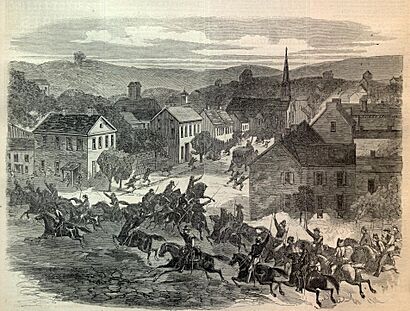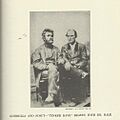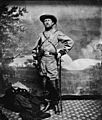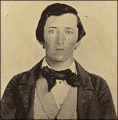Guerrilla warfare in the American Civil War facts for kids
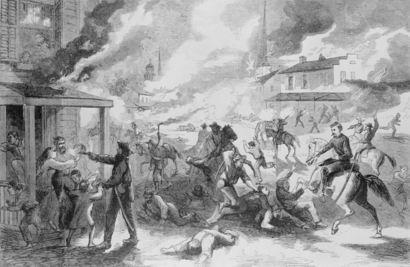
During the American Civil War (1861–1865), a special kind of fighting called guerrilla warfare took place. It wasn't like big armies fighting on battlefields. Instead, small groups of fighters used surprise attacks and quick raids. Both sides, the Union and the Confederacy, used these tactics. However, the Confederate side was more known for it. This type of fighting became more intense as the war went on.
Contents
What is Guerrilla Warfare?
Guerrilla warfare during the American Civil War was similar to other irregular fighting styles in the 1800s. It involved small groups fighting against larger, more organized armies. This type of warfare can be split into three main kinds of operations:
- 'People's war'
- 'Partisan warfare'
- 'Raiding warfare'
Each of these had its own unique features during the war.
Types of Guerrilla Operations
People's War: Neighbors Fighting Neighbors
The idea of a 'people's war' means that ordinary citizens get involved in the fighting. It was the closest thing to a large-scale guerrilla movement during the 1800s. In the Civil War, this type of fighting often happened in the countryside of the border states. These included Missouri, Arkansas, Tennessee, Kentucky, and parts of Virginia.
This fighting was often very harsh. Neighbors would fight against neighbors, sometimes because of old disagreements. It was common for people from one part of a county to fight those from another. This kind of warfare included surprise attacks from hidden places (bushwhacking), murder, and acts of terror. Most people involved didn't wear uniforms or belong to the official armies. Often, civilians fought against other civilians, or civilians fought against enemy soldiers.
Partisan Warfare: Special Forces
Partisan warfare was more like the special operations or commando missions we see today. Partisans were small military units. They were controlled by a regular army and sent behind enemy lines to cause trouble. The Confederate Congress passed the Partisan Ranger Act in 1862. This law allowed these units to form and made them official. This was different from common 'bushwhackers' or 'guerrillas'.
One famous partisan leader was John Singleton Mosby. He formed a unit called the 43rd Battalion. This group was very good at keeping Union forces busy behind their lines in northern Virginia. Other groups like Blazer's Scouts and McNeill's Rangers sometimes served with the regular armies. But they often acted more like partisans, especially early in the war.
Raiding Warfare: Deep Strikes
Finally, large raids by regular cavalry forces were sometimes seen as 'irregular'. The "Partisan Brigades" of Nathan Bedford Forrest and John Hunt Morgan were part of the Confederate cavalry. They had specific jobs to destroy important supply centers, railroad bridges, and other targets. This helped the larger mission of the Confederate Army of Tennessee.
John Hunt Morgan led raids into Kentucky. In his last raid, he went against orders and crossed the Ohio River. He raided towns in Ohio and Indiana because he wanted to bring the war directly to the North. This long raid forced thousands of Union troops to chase him. Morgan captured many soldiers, destroyed bridges, and took livestock. By mid-1863, most of Morgan's Raiders were defeated during the Great Raid of 1863.
Some of his followers, like Marcellus Jerome Clarke, continued raiding in Kentucky on their own. The Confederacy did fewer deep cavalry raids later in the war. This was mainly because they lost many experienced horsemen. The Union Army also became better at offensive operations. The Union cavalry also conducted successful raids. A good example was Grierson's Raid in 1863. This raid helped General Ulysses S. Grant win the Vicksburg Campaign.
Stopping Guerrilla Fighters
The Union army worked to stop Confederate guerrilla warfare. In Arkansas, Union forces used many different plans to defeat these irregular fighters. They used Arkansas Unionist troops to fight guerrillas. They also used gunboats on rivers to control waterways. The military police system (provost marshal) spied on suspected guerrillas and jailed those they caught.
To fight Confederate raiders, the Union army built up its own strong cavalry. They also built many small forts (blockhouses) to protect important targets. However, Union efforts to defeat Mosby's Partisan Rangers were not fully successful. This was because Mosby used very small groups (10–15 men). They operated in areas where people supported the Confederates.
Another group, known as Thomas' Legion, included white and anti-Union Cherokee Indians. This group became a guerrilla force. They kept fighting in the remote mountains of western North Carolina for a month after Robert E. Lee surrendered. Union forces never fully stopped this unit. But they voluntarily stopped fighting after capturing the town of Waynesville, North Carolina, on May 10, 1865.
After the War
After the Civil War, some historians looked at why the Confederate government decided not to continue fighting as a guerrilla war. Near the end of the war, some Confederate leaders wanted to keep fighting using guerrilla tactics. However, Confederate generals like Lee disagreed. They believed that surrendering and making peace was the best choice for the South, which had been badly damaged by the war.
Notable Guerrillas
-
James H. Lane
USA -
John S. Mosby
CSA -
John Hunt Morgan
CSA -
M. Jerome Clarke, aka "Sue Mundy"
CSA -
Champ Ferguson
CSA -
Jesse James and Frank James
CSA -
Cole Younger
CSA -
.
Jim Younger
CSA
See also
- Bushwhackers - (Confederate)
- Jayhawkers - (Union)
- Partisan rangers - (Confederate)


